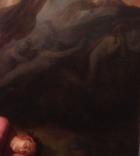Daughter of Guido I da Polenta of Ravenna, Francesca was wedded in or around 1275 to the brave, yet crippled Giovanni Malatesta (also called Gianciotto; "Giovanni the Lame"), son of Malatesta da Verucchio, lord of Rimini.[1] The marriage was a political one; Guido had been at war with theMalatesta family, and the marriage of his daughter to Giovanni was a way to solidify the peace that had been negotiated between the Malatesta and the Polenta families. While in Rimini, she fell in love with Giovanni’s younger (and still hale) brother, Paolo. Though Paolo too was married, they managed to carry on an affair for some ten years, until Giovanni ultimately surprised them in Francesca’s bedroom sometime between 1283 and 1286, killing them both.
In the years following Dante's portrayal of Francesca, legends about Francesca began to crop up. Chief among them was one put forth by poet Giovanni Boccaccio in his commentary on The Divine Comedy, Esposizioni sopra la Comedia di Dante; he stated that Francesca had been tricked into marrying Giovanni through the use of Paolo as a proxy. Guido, fearing that Francesca would never agree to marry the crippled Giovanni, had supposedly sent for the much more handsome Paolo in Giovanni's stead. It wasn't until the morning after the wedding that Francesca discovered the deception. This version of events, however, is very likely a fabrication. It would have been nearly impossible for Francesca not to know who both Giovanni and Paolo were, and to whom Paolo was already married, given the dealings the brothers had had with Ravenna and Francesca's family. Also, Boccaccio was born in 1313, some 27 years after Francesca’s death, and while many Dante commentators after Boccaccio echoed his version of events, none before him mentioned anything similar.
In the first volume of The Divine Comedy, Dante and Virgil meet Francesca and her lover Paolo in the second circle of hell, reserved for the lustful. Here, the couple is trapped in an eternal whirlwind, doomed to be forever swept through the air just as they allowed themselves to be swept away by their passions. Dante calls out to the lovers, who are compelled to briefly pause before him, and he speaks with Francesca. She obliquely states a few of the details of her life and her death, and Dante, apparently familiar with her story, correctly identifies her by name. He asks her what led to her and Paolo’s damnation, and Francesca’s story strikes such a chord within Dante that he faints out of
French painter of Dutch and German extraction, was born in Dordrecht. After the early death of his father Johann Baptist, a poor painter, Ary's mother Cornelia, herself a painter and daughter of landscapist Arie Lamme, took him to Paris and placed him in the studio of Pierre-Narcisse Guérin. When Scheffer left Guérin's studio, Romanticism had come into vogue in France, with such painters as Xavier Sigalon, Eugène Delacroix and Théodore Géricault. Scheffer did not show much affinity with their work and developed his own style, which has been called "frigidly classical". Scheffer often painted subjects from literature, especially the works of Dante, Byron and Goethe. Two versions of Dante and Beatrice and have been preserved at Wolverhampton Art Gallery, United Kingdom, and Museum of Fine Arts, Boston, USA. Particularly highly praised was his Francesca da Rimini painted in 1836. Ary Sheffer's popular Faust-themed paintings include Margaret at her wheel; Faust doubting; Margaret at the Sabbat; Margaret leaving church; The garden walk, and Margaret at the well. In 1836, he painted two pictures of Goethe's character Mignon. He now turned to religious subjects: Christus Consolator (1836) was followed by Christus Remunerator, The shepherds led by the star (1837), The Magi laying down their crowns, Christ in the Garden of Olives, Christ bearing his Cross, Christ interred (1845), and St Augustine and Monica (1846). His Christus Consolator, lost for 70 years, was rediscovered in a janitor's closet in Gethsemane Lutheran Church in Dassel, Minnesota in 2007. It has been restored and is on display at the Minneapolis Institute of Arts. Scheffer was also an accomplished portrait painter. His subjects included composers Frédéric Chopin and Franz Liszt, the Marquis de la Fayette, Pierre-Jean de Béranger, Alphonse de Lamartine, Charles Dickens, Duchess de Broglie, Talleyrand and Queen Marie Amélie. After 1846, he ceased to exhibit. His strong ties with the royal family caused him to fall out of favour when, in 1848, the Second Republic came into being. Shut up in his studio, he produced many paintings that were only exhibited after his death, which took place at Argenteuil on the 15th of June 1858. He is buried in the Cimetière de Montmartre. The works first exhibited posthumously include Sorrows of the earth, and the Angel announcing the Resurrection, which he had left unfinished. By the time of his death, his reputation was damaged: though his paintings were praised for their charm and facility, they were condemned for poor use of color and vapid sentiment. Scheffer was married to the widow of General Baudrand. His brother Hendrik, born at the Hague on 27 September 1798, was also a prolific painter. Scheffer was made commander of the Legion of Honour in 1848, that is, after he had wholly withdrawn from the Salon. The painting illustrates a famous episode from the fifth canto of Dante's Inferno, in which Dante and Virgil see Paolo and Francesca condemned to the darkness of Hell with the souls of the lustful.



